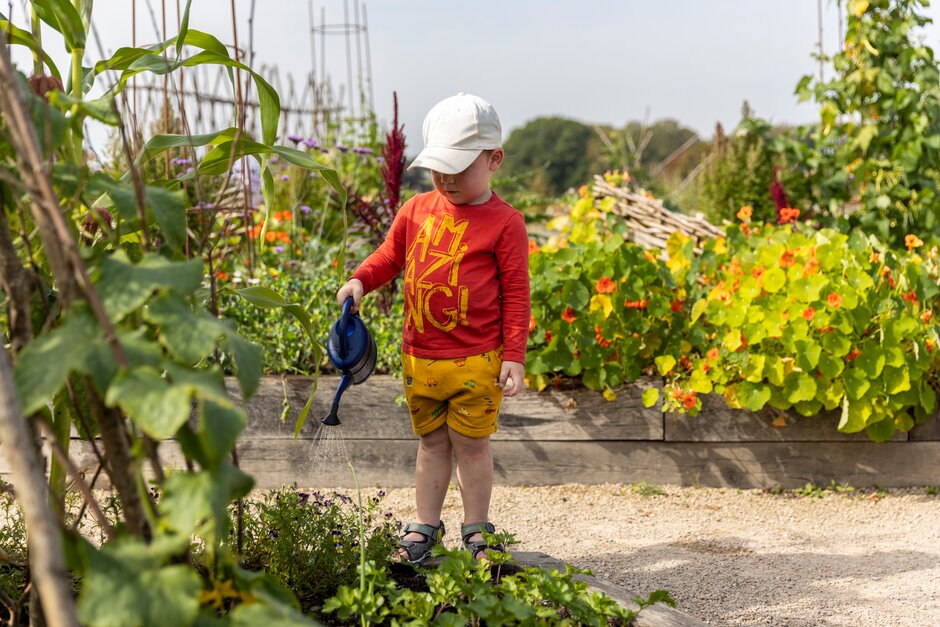Personal, social and Emotional Development
Participating in the National Education Nature Park encourages children to connect with nature to improve their physical and emotional wellbeing. Spending time in nature is proven to increase feelings of happiness by increasing the body's production of dopamine and endorphins. Just a short time outside can support concentration and reduce symptoms of anxiety. Spending time outdoors is, therefore, important to our littlest learners. By participating in the Nature Park, learners’ can be supported to develop a positive relationship with nature and learn that their actions can have a positive impact on the world.
Adult-led Activity Suggestions
- Invite learners to explore the different emotions associated with nature while looking closely at the features of trees. In this activity learners will create tree faces using clay that represent different emotions. These can remain on the trees to help facilitate future circle times or encourage role play.
- Encourage learners to share their ideas, experiences and relationships from home by creating a portrait using natural objects from nature.
- Work in pairs to search for leaves around your setting. Use these leaf ID guides to match the leaves to the picture. As a facilitator, model looking at the following elements of a leaf; texture, veins, colour, shape of edges, size and number of leaves. Encourage students to compare and analyse different leaves.
- Nature Park activity: Leaf Identification - this activity encourages learners to look closely and start to identify the similarities and differences of trees found in their outdoor space. They will ask questions and ‘really look’ to try and find the tree the leaf came from. This also introduces the concept of identifying plants in their site, by exploring the space and making observations.
- Nature Park activity: Colour collecting - this activity will encourage learners to explore their outdoor space using colours, thinking about why they might find different colours and shades around their site.
Continuous Provision: Planting
Planting and growing food can be a fantastic way to connect to nature and help learners to begin to grasp where their food comes from. This can be adapted for most settings from planting in pots or tyres in an urban setting, creating flower beds on concrete surfaces, to assigning part of the field to be a designated food growing area. Plants, which make up a large proportion of our diet, are crucial for our health and wellbeing. Both healthy eating and taking part in planting experiences improve mental and physical health and wellbeing. Here are some top planting tips for your setting.
Tips for growing in pots with at least 30cm diameter:
- Ensure pots have drainage
- Fill with peat-free compost
- Choose smaller crops
- Water more regularly than plants in larger spaces
- Use tomato feed to encourage growth
- Top 3 plant pot crops; courgette, French beans, bush tomatoes
- Create a watering schedule or plant monitors to ensure the plants stay hydrated. Children can dip their finger in the soil to test how moist the soil is and predict how much water is needed
Tips for growing in the ground:
- Dig a hole – take your time with this part, it is a powerful learning experience in itself
- Remove weeds – a great task for little learners to explore plant parts
- Fill hole with peat-free compost – potential to use children’s mud potions around the outside
- Top 3 ground crops; rocket (with edible flowers), strawberries, raspberries
Tips for a Runner Bean wigwam
- Follow the same steps as above and then create a simple teepee from bamboo canes
- Plant beans around the canes and water often
Equipment Needed
- Hand trowel or fork
- Watering can
- Gardening gloves if removing weeds
- Spade and rake if digging in the ground
Leave a pot or space open so that children can explore the soil throughout the seasons.
Green Skills Development
- Identify and Ecology Skills
- Decision making and creative thinking.
- Environmental Stewardship and horticulture

© RHS, Credit: RHS / Josh Kemp-Smith
Thumbnail image: © RHS, Credit: RHS / Helen Yates
Early learning goal outcomes
- Be confident to try new activities and show independence, resilience and perseverance in the face of challenge.
- Work and play cooperatively and take turns with others.
- Set and work towards simple goals, being able to wait for what they want and control their immediate impulses when appropriate.